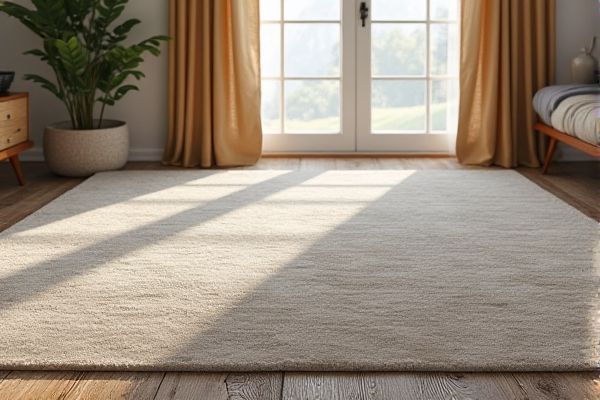
Choosing between a rug pad and carpet underlay depends on your flooring needs, as rug pads provide cushioning and prevent slipping specifically for area rugs, while carpet underlays offer full-room support and insulation beneath wall-to-wall carpeting. Explore this article to understand which option best enhances Your floor's comfort, durability, and appearance.
Table of Comparison
| Feature | Rug Pad | Carpet Underlay |
|---|---|---|
| Purpose | Prevents rug slipping, adds cushioning, protects floor | Provides carpet support, insulation, and extends carpet life |
| Thickness | Typically 1/8" to 1/4" | Ranges from 1/4" to 1/2" or more |
| Material | Rubber, felt, or synthetic blends | Foam, felt, rubber, or fiber-based materials |
| Cushioning | Moderate cushioning for rugs | Thicker cushioning for full carpet comfort |
| Slip Resistance | High - designed to grip floor and rug | Low - mainly supports carpet, not rugs |
| Floor Protection | Protects hardwood and tile floors from scratches | Protects subfloor but less focused on hardwood protection |
| Installation | Placed under area rugs only | Installed under wall-to-wall carpet |
| Durability | Designed for lighter use with area rugs | Built for heavy foot traffic and long-term use |
Rug Pad vs Carpet Underlay: Key Differences
Rug pads are thinner and specifically designed to prevent slipping and protect floors beneath area rugs, whereas carpet underlays are thicker, providing cushioning and insulation under wall-to-wall carpets. Rug pads enhance rug longevity and improve comfort without altering carpet height significantly, while carpet underlays increase overall carpet thickness for added comfort and soundproofing. Choosing between the two depends on the type of flooring and the desired level of support and protection.
What Is a Rug Pad?
A rug pad is a thin layer of material placed beneath area rugs to provide cushioning, prevent slipping, and protect floors from damage. Unlike carpet underlay, which is thicker and used under wall-to-wall carpeting, rug pads are specifically designed to enhance rug comfort, extend rug life, and improve safety by reducing movement. Popular rug pad materials include felt, rubber, and a combination of both for optimal grip and support.
What Is Carpet Underlay?
Carpet underlay is a layer of cushioning material installed beneath your carpet to enhance comfort, insulation, and durability. It helps absorb impact, reduces noise, and extends the lifespan of the carpet by preventing wear and tear. Choosing the right carpet underlay ensures better performance and adds value to your flooring investment.
Material Comparison: Rug Pad and Carpet Underlay
Rug pads are typically made from materials like natural rubber, felt, or memory foam, offering cushioning and non-slip properties ideal for smaller rugs. Carpet underlays consist mainly of foam, rubber, or fiber, designed to provide extensive support and insulation beneath wall-to-wall carpeting. Choosing the right material affects durability, comfort, and floor protection, ensuring your rug or carpet performs optimally in your space.
Installation Process: Rug Pads vs Carpet Underlays
Rug pads typically feature a simple installation process, requiring you to place them directly beneath your rug to prevent slipping and extend its lifespan. Carpet underlays, on the other hand, involve a more complex installation as they are laid beneath wall-to-wall carpets, often requiring professional fitting to ensure proper cushioning and insulation. Choosing the right option depends on your flooring needs, with rug pads offering easy, versatile placement, while carpet underlays provide comprehensive support for full carpet installations.
Comfort and Cushioning: Which Offers More?
Carpet underlay generally provides superior comfort and cushioning compared to rug pads due to its thicker and denser foam or felt materials specifically designed to absorb impact and reduce floor hardness. Rug pads, while offering some cushioning, primarily focus on preventing slippage and protecting floors rather than maximizing softness underfoot. For enhanced comfort, especially in high-traffic areas or rooms where prolonged standing occurs, choosing a high-quality carpet underlay is typically more effective than a standard rug pad.
Protection and Longevity for Floors and Rugs
Rug pads and carpet underlays both protect floors and extend the life of rugs by preventing slipping and reducing wear. Rug pads provide cushioning tailored for area rugs, enhancing durability and preventing floor scratches, while carpet underlays offer thicker support beneath wall-to-wall carpets for extended comfort and insulation. Choosing the right option ensures your floors and rugs maintain their appearance and longevity over time.
Noise Reduction: Rug Pad vs Carpet Underlay
Rug pads and carpet underlays both enhance noise reduction by absorbing sound, but carpet underlays typically offer superior acoustic insulation due to their thicker and denser foam or rubber composition. Rug pads primarily prevent slippage and provide cushioning, contributing to moderate sound dampening, whereas carpet underlays significantly reduce impact noise and airborne sound between floors. Selecting a carpet underlay with high-density foam or felt materials maximizes noise reduction in residential and commercial spaces.
Cost Analysis: Rug Pads Compared to Carpet Underlays
Rug pads generally cost less than carpet underlays, making them a budget-friendly option for protecting flooring and extending rug life. While carpet underlays provide thicker cushioning and insulation, they come with higher installation and material expenses, often doubling or tripling the price of rug pads. Your decision should balance the initial cost with the desired comfort and durability benefits each option offers.
Choosing the Right Option: Rug Pad or Carpet Underlay
Selecting the ideal floor protection depends on the specific use and material; rug pads typically offer cushioning and grip for area rugs, preventing slips and extending rug life with materials like natural rubber or felt. Carpet underlay, designed primarily for wall-to-wall carpeting, provides enhanced insulation, soundproofing, and comfort through thicker foam or rubber layers. Assessing the rug type, floor surface, and desired durability is crucial in determining whether a rug pad or carpet underlay best suits your interior needs.
 homyna.com
homyna.com